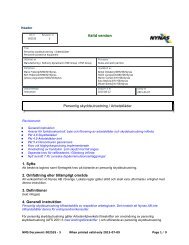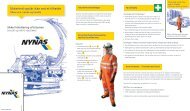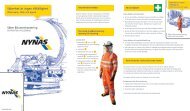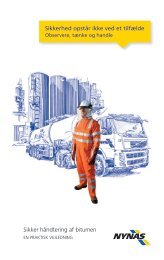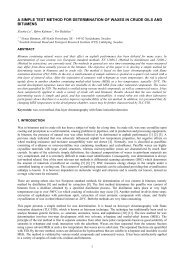High Resistance Polymermodified Binders to Secure ... - Nynas
High Resistance Polymermodified Binders to Secure ... - Nynas
High Resistance Polymermodified Binders to Secure ... - Nynas
You also want an ePaper? Increase the reach of your titles
YUMPU automatically turns print PDFs into web optimized ePapers that Google loves.
Rheometer (BBR) which make it even better <strong>to</strong> describe the performance related<br />
binder properties.<br />
2. Development of PmB with <strong>High</strong> <strong>Resistance</strong> (HR) Properties<br />
<strong>Nynas</strong> Bitumen developed two grades of <strong>High</strong> <strong>Resistance</strong> (HR) polymermodified<br />
binders that are named in the style of the German TL PmB concerning the PmB 25<br />
and the PmB 45.<br />
Both grades the Nypol 25 HR and the Nypol 45 HR have a higher polymer content<br />
based on selected SBS with special additives by using venezuelan base bitumen<br />
which in combination guaranteed the postulated performance. Both grades are of<br />
course cross-linked <strong>to</strong> guarantee the necessary s<strong>to</strong>rage stability especially for higher<br />
polymermodified binders.<br />
2.1 Handling and S<strong>to</strong>rage<br />
The <strong>High</strong> <strong>Resistance</strong> PmB’s should be treated as a normal high polymermodified<br />
binder. The delivery and s<strong>to</strong>rage temperature is around 180 °C. The HR PmB’s are<br />
stable in s<strong>to</strong>rage but for periods of longer than one week the s<strong>to</strong>rage temperature<br />
should be lowered <strong>to</strong> around 140 °C. Reheating should take place gradually, where<br />
possible in a tank with an agita<strong>to</strong>r or with simultaneous pump circulation. The s<strong>to</strong>rage<br />
temperature should not exceed 190 °C.<br />
2.2 Mixing and Transport<br />
The asphalt which is made with the HR PmB’s is mixed in the usual sequence where<br />
the temperature of the binder should be around 180 °C. The temperature of the<br />
asphalt mixture should be between 170 °C and 180 °C. The mixture can be s<strong>to</strong>red<br />
briefly in silos provided these are designed <strong>to</strong> prevent caking at the silo outlet, e.g.<br />
with stainless steel lining and heated silo shutters. The mixture must be transported<br />
that it cools down as less as possible. Covering the mix is absolutely essential.<br />
2.3 Laying, Compaction and Testing<br />
The asphalt mixture made with HR PmB’s should in principle be laid mechanically;<br />
manual laying should be limited <strong>to</strong> an absolute minimum. The laying temperature<br />
should be around 170 °C. Compaction should take place with heavy static rollers<br />
and / or heavy vibra<strong>to</strong>ry rollers, and be completed at a mixture temperature of at least<br />
100 °C.<br />
The HR PmB’s can be extracted from the asphalt mixture with trichloroethylene or<br />
<strong>to</strong>luene. The extraction time must be extended by at least 30 minutes that all<br />
polymers and additives are reliably dissolved.<br />
2.4 Performance of <strong>High</strong> <strong>Resistance</strong> (HR) PmB<br />
The development of the high resistance PmB started with the project of the Container<br />
Terminal in Hamburg (Germany). The tender described the specification for an<br />
special higher polymermodified binder. This project is described in further details in<br />
chapter 3.1.


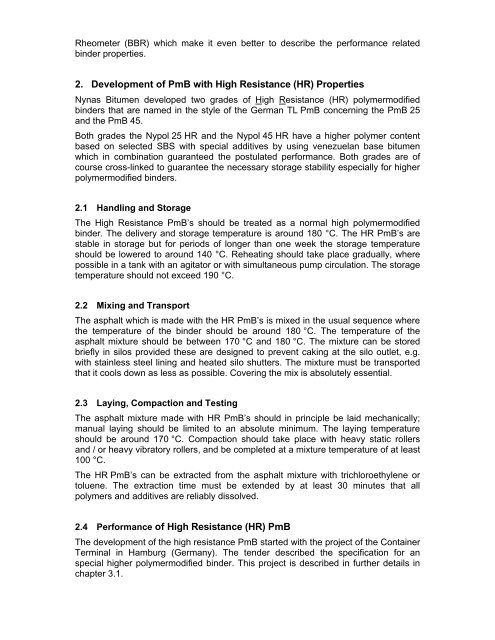
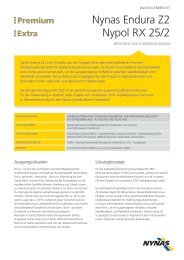
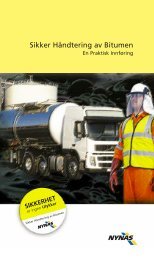

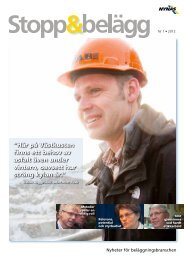
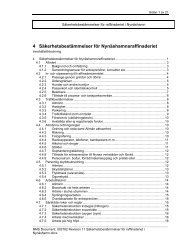
![Säkerhetsbestämmelser Gbg rev 5.ppt [Compatibility Mode] - Nynas](https://img.yumpu.com/18742268/1/190x146/sakerhetsbestammelser-gbg-rev-5ppt-compatibility-mode-nynas.jpg?quality=85)
